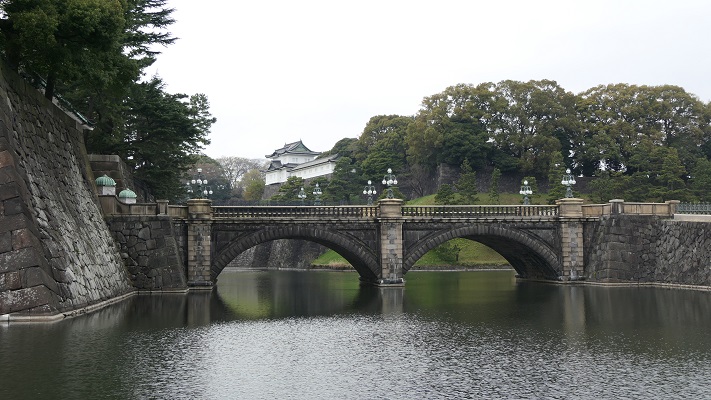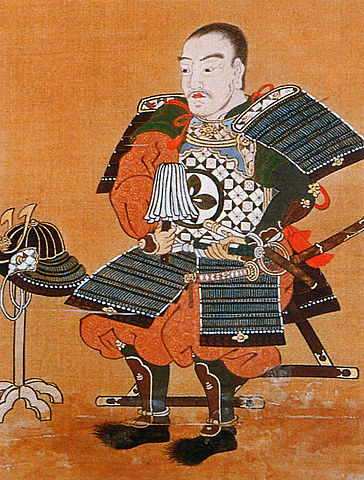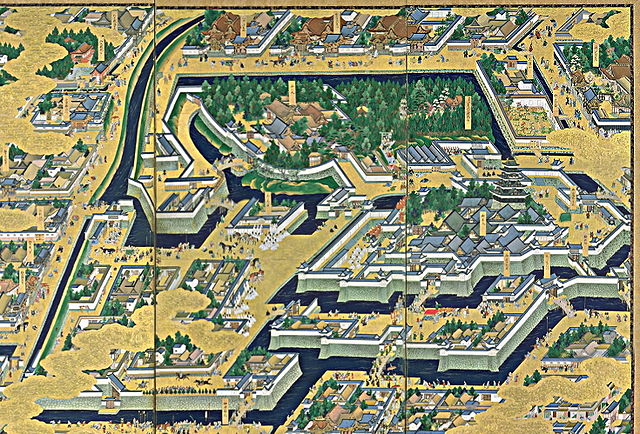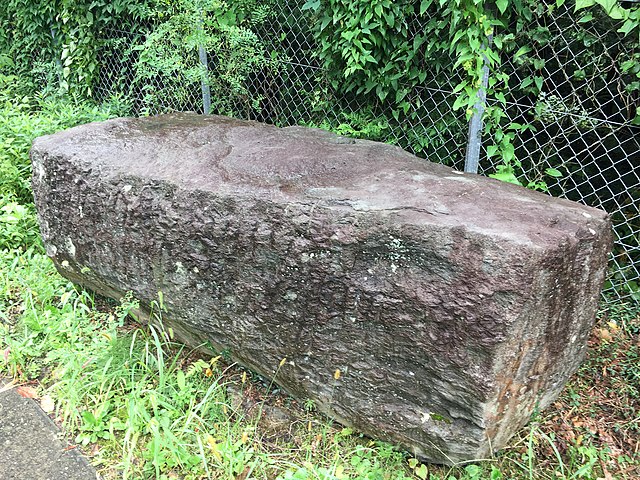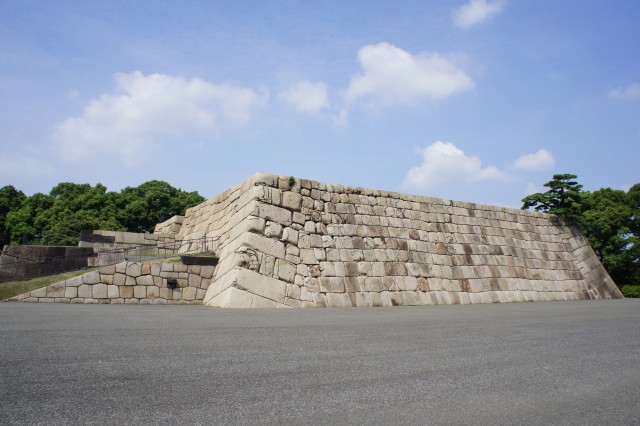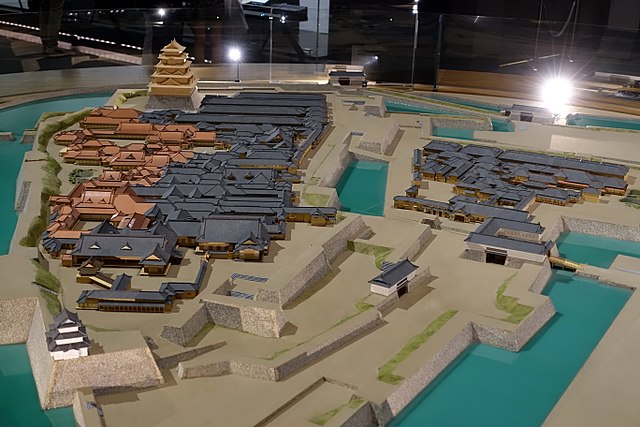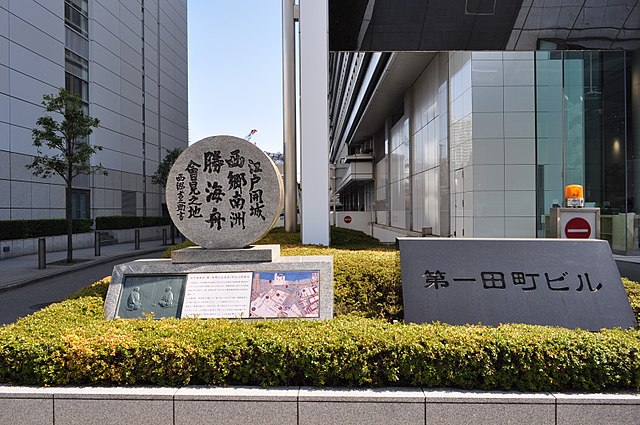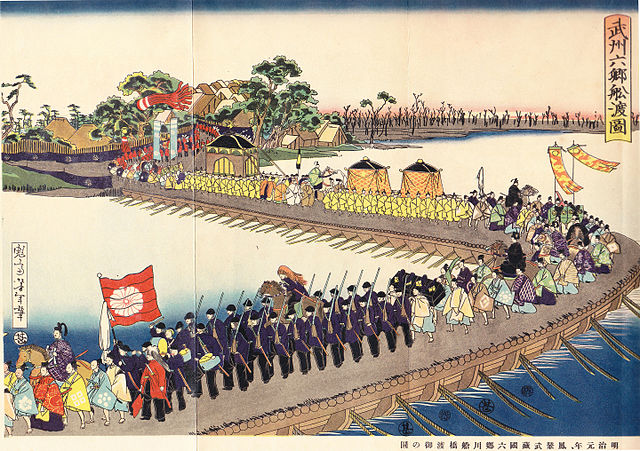
立地と歴史~Location and History
広島は今、平和を希求する都市となっています。この都市は毛利氏により築かれた広島城から始まりました。毛利氏もともと吉田郡山城という広大な山城に住んでいましたが、その城は戦国時代において防御力に優れていました。しかし統治や通商には不向きだったのです。豊臣氏による天下統一の後、毛利輝元は当時の他の事例にならい、本拠地を他の地に移すことにしました。彼は1589年に太田川のデルタ地帯にある島の上に新しい城を築きはじめました。この城と城下町は南方の海の方角に向かって広がっていきました。
Hiroshima is now a city for promoting peace. The city comes from Hiroshima Castle built by the Mori clan. The clan originally lived in a large mountain castle called Yoshida-Koriyama which was specialized for defense in the Warring States Period. But it was not convenient for governance and business. After the unification of the whole country by the Toyotomi clan, Terumoto Mori decided to move his home base to another place by emulating other cases at that time. He started to build a new castle on an island on the delta of Otagawa River in 1589. The area of the castle and its town spread towards the sea in the south.
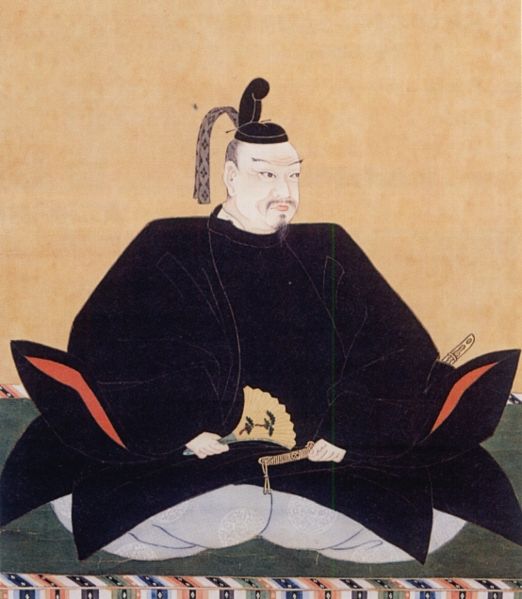
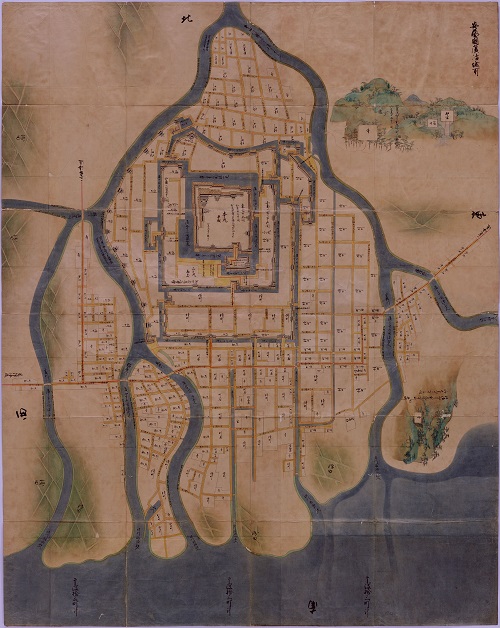
徳川幕府が設立されてから後に、福島氏が城を完成させたと言われています。城には5層の天守の他、88もの櫓がありました。主要な曲輪は水堀により区切られて、橋でのみつながっていました。また、他の川や堀によっても囲まれていました。代わりにこのような環境下では、洪水から被害を受けやすくなります。福島は洪水の度に城を補修せざるを得ませんでした。しかながら、頻繁な工事は幕府に福島が反乱を起こすのではないかと疑念を生じさせ、福島は1619年に改易となってしまいます。
After the Tokugawa Shogunate was established, it is said that the Fukushima clan completed the castle. It had a five layer Tenshu keep and 88 turrets. Primary enclosures were separated by water moats, connected by only bridges. They were also surrounded by many other rivers and moats. Instead, in such conditions, it could suffer from flooding. Fukushima had to repair the castle constantly after floods. However, frequent constructions made the Shogunate doubt Fukushima might be against the Shogunate. Fukushima was fired in 1619.

その後、浅野氏が広島を250年以上統治しました。浅野氏は城をほとんど同じ状態で維持しましたが、市街地や農地を埋め立てにより拡張しました。埋め立て地は、広島市の礎になっています。
After that, the Asano clan governed Hiroshima for 250 years. They had kept the castle almost the same as original. They continued to reclaim land for towns and fields. The reclaimed area is the foundation of Hiroshima City.
特徴~Features
現在、主に本丸と二の丸の跡地が内堀に囲まれて残っています。そこには現存建物はありません。天守は本丸の北西隅に外観復元されています。その内部は歴史博物館として使われていて、広島市や広島城の歴史を学ぶことができます。二の丸は外部から本丸に向かう途中に、出丸のようになっていて、周りの内堀により独立しています。とても独特なスタイルです。
Now, ruins of mainly Honmaru and Ninomaru enclosures surrounded by the inner moat remain. No remaining buildings are there. The Tenshu has been apparently restored at the north-west corner of Honmaru. Its interior is used as a historical museum where you can learn about the history of the city and castle. Ninomaru is like a barbican on the way from outside to Honmaru, isolated by the inner moat around. It’s a very unique style.
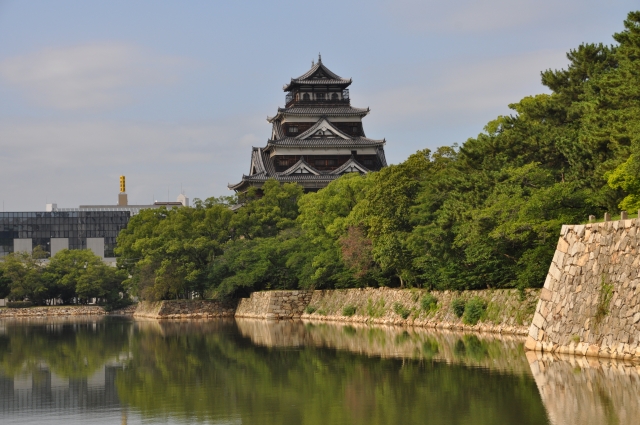
二の丸では、表御門や太鼓櫓といったいくつかの建物が最近になって元来の工法で復元されています。
Several buildings like the Front Gate and the Drum Turret were recently restored in the original way at Ninomaru.
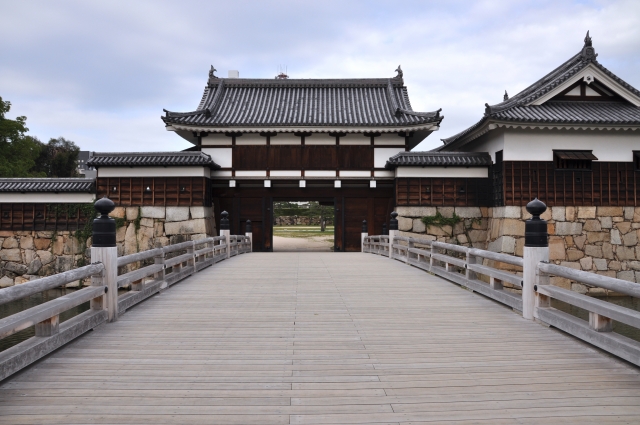
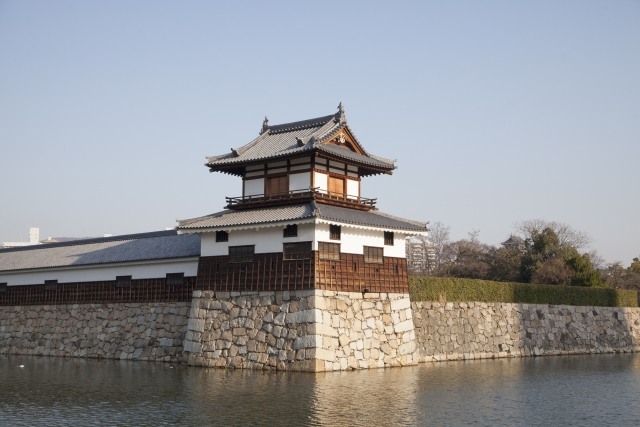
その後~Later Life
この城の近代の歴史はより過酷だったかもしれません。明治維新後、城跡は日本陸軍の広島鎮台の用地に転用されました。多くの城の建物は軍施設に置き換わりました。特に、1894年の日清戦争時には大本営が移ってきました。明治天皇が東京からここに来て、直接軍隊を指揮したのです。近くの宇品には大きな軍港もあり、広島は第二次世界大戦までは軍都として繁栄したのでした。
The modern history of the castle might be stormier. After the Meiji Restoration, the ruins of the castle were turned into the ground for Hiroshima Chindai of the Japanese Army. Many castle buildings were replaced with military facilities. In particular, the Imperial Headquarters was relocated there during the Sino-Japanese War in 1894. Emperor Meiji moved there from Tokyo to order his soldiers. There was a large navy port called Ujina nearby, and Hiroshima had been a military-based city until World War II.

1945年8月、広島の人たちはなぜ大きな空襲がここにはないのか訝しんでいました。それは、広島が原子爆弾の標的の一つだったからでした。8月6日の朝、8時15分、原爆は非戦闘員、婦女子を含む約15万人もの人たちを殺し、市街地のすべての建物を破壊しました。現存していた広島城の天守は、原爆の爆風により一瞬のうちに倒壊し、それから燃え出しました。
In August 1945, people in Hiroshima were wondering why they didn’t suffer from large air raids. That was because the city was one of the targets of the atomic bombs. At 8:15 AM on August 6, the bomb killed around 150,000 people including non-combatants, women and children as well as all of the buildings in the city area. The remaining Tenshu keep of Hirosima Castle collapsed in an instant by the bomb blast before burning out.
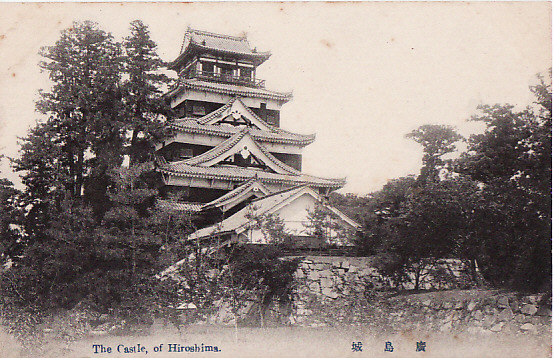
戦後になって、人々は焼土となった城跡をどう扱うべきか議論を行いました。1951年の広島国体の間のみ仮の天守が作られました。そのとき人々は広島の平和と復興のシンボルとして天守が必要だと気付いたのです。そのため、現在の天守が1958年に外観復元されました。
After the war, people discussed how they should treat the burned ruins of the castle. When the temporary Tenshu was built in 1951 just during a National Sports Festival in Hiroshima, they realized that they need to rebuild the Tenshu as a symbol of peace and restoration for the city. That’s why the present Tenshu was apparently restored in 1958.
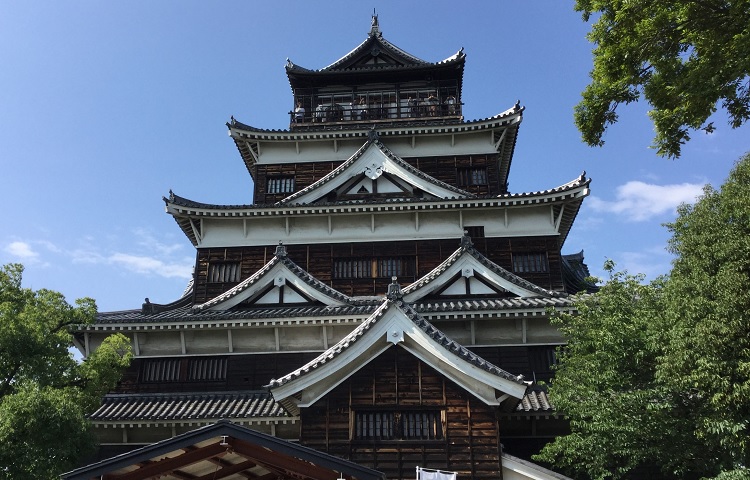
私の感想~My Impression
広島城は、城の存在意義が戦争から平和のためにと変わっていった典型例でしょう。日本のプロ野球球団、広島東洋カープの「カープ」という名前は、この城の愛称「鯉城」から来ています。この城が末永く平和と繁栄のシンボルであり続けるよう願ってやみません。
Hiroshima Castle is a typical example of a castle’s role being turned from war into peace. Hiroshima Toyo Carp is a Japanese pro baseball team. The name “Carp” comes from the castle’s nickname, the Carp Castle “Ri-Jo”. I hope that the castle will be a symbol of peace and prosperity now and forever.
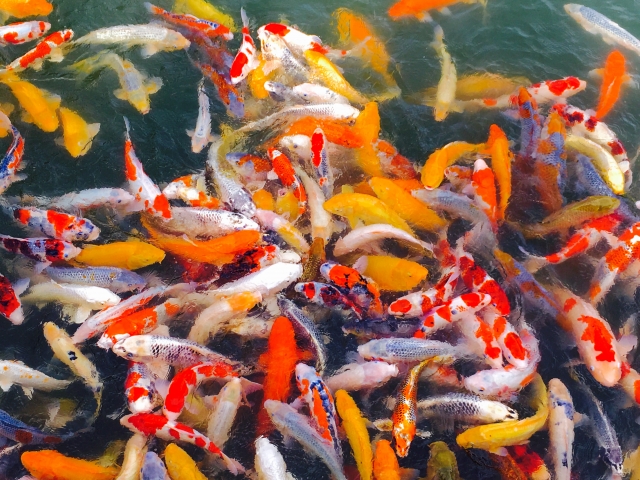
ここに行くには~How to get There
広島駅から:徒歩で約25分かかります。市内電車の場合1・2・6番電車に乗り、紙屋町東停留所で降りてください。バスの場合は広島駅南口バスターミナルで7・8・9番乗り場から乗り、合同庁舎前バス停で降りてください。
車で行く場合:山陽自動車道の広島ICから約10分かかります。城の周りにいくつか駐車場があります。
From Hiroshima station: It takes about 25 minutes on foot. Or take the tram line 1, 2, or 6, and take off at the Kamiyacho-Higashi stop. Or take the bus line 7, 8, or 9 at Hiroshima Station south exit bus terminal, and take off at the Godochosha-Mae bus stop.
If you want to go there by car: It takes about 20 minutes from the Hiroshima IC on San-yo Expressway. There are several parking lots around the castle.
リンク、参考情報~Links and Rererences
・広島城公式ホームページ~Hiroshima Castle
・広島城400年、中国新聞社編、第一法規(Japanese Book)
・決戦!広島城、松永弘高著、朝日新聞出版(Japanese Book)
・よみがえる日本の城7、学研(Japanese Book)

